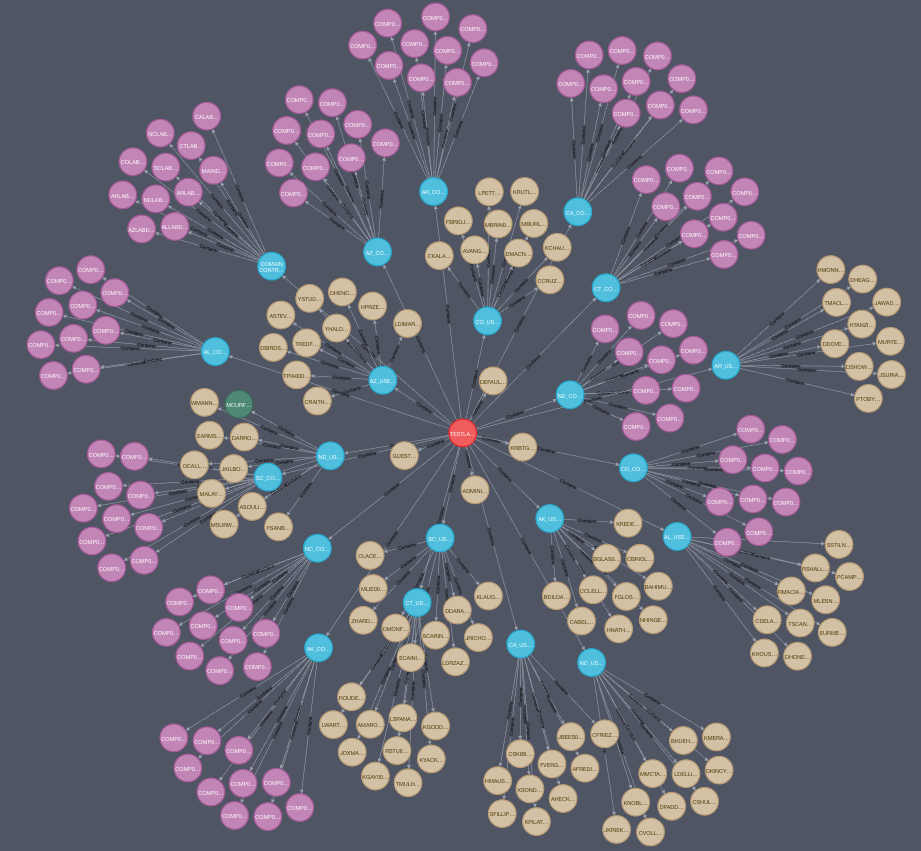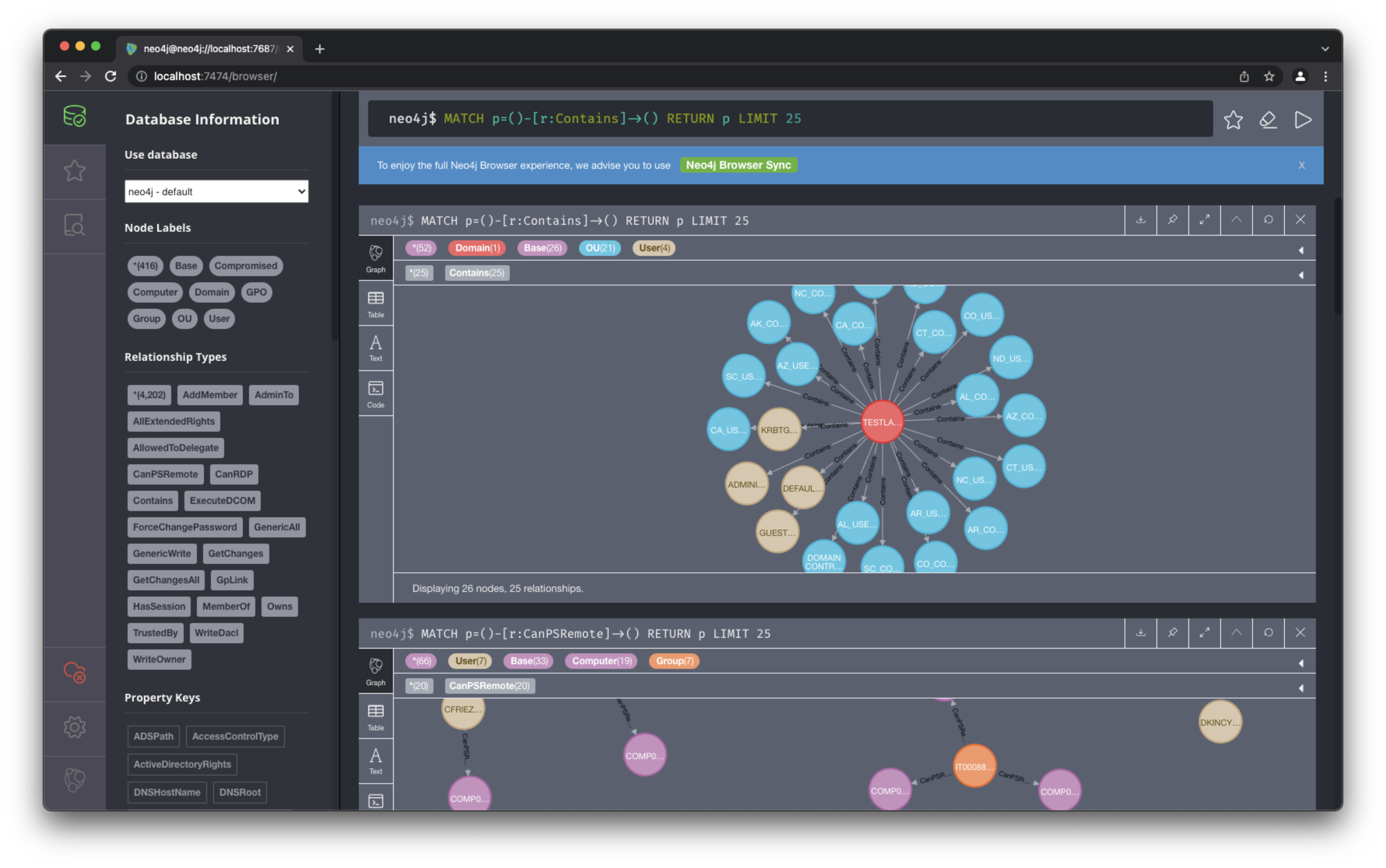,.,
MMMM_ ,..,
"_ "__"MMMMM ,...,,
,..., __." --" ,., _-"MMMMMMM
MMMMMM"___ "_._ MMM"_."" _ """""" _ _ _ _
""""" "" , \_. "_. ." __ _ __| |___(_)_ __ ___ _ _| | __ _| |_ ___ _ __
,., _"__ \__./ ." / _` |/ _` / __| | '_ ` _ \| | | | |/ _` | __/ _ \| '__|
MMMMM_" "_ ./ | (_| | (_| \__ \ | | | | | | |_| | | (_| | || (_) | |
'''' ( ) \__,_|\__,_|___/_|_| |_| |_|\__,_|_|\__,_|\__\___/|_|
._______________.-'____"---._.
\ /
\________________________/
(_) (_)
Author: Nicolas Carolo nicolascarolo.dev@gmail.com
Copyright: © 2022, Nicolas Carolo.
Date: 2022-06-29
Version: 1.1.1
adsimulator is a graph-based tool for the simulation of realistic Active Directory environments. The graph models are generated according to a customizable list of requirements and represent the relationships between the nodes of an Active Directory domain. Finally, graphs are stored in a Neo4j graph database instance. This tool is inspired by DBCreator, but it provides more features.
The ability to generate graphs according to specific requirements is the most relevant functionality offered by adsimulator. For example, it is possible to generate environments affected by vulnerabilities (e.g., various types of ACL misconfigurations, inadequate security policies) that make them possible targets of cyber-attacks, such as AS-REP Roasting and DCSync. In addition, it is possible to choose the size of Active Directory environments by setting up the number of domain trusts, Security Principals, OUs, and GPOs. Moreover, it is possible to set the probabilities associated with object properties.
The following table summarizes the most relevant parameters used in the generation of an Active Directory domain.
| Object | Property | Description | Value |
|---|---|---|---|
| ACL | ACLsProbability |
Probability of each access control right (e.g., GenericAll, AddMember, WriteDacl) |
Integer for each right (0-100). The sum of the probabilities must be equal to 100 |
| Computer | nComputers |
Number of computers | Integer > 0 |
| Computer | CanRDPFromUserPercentage CanRDPFromGroupPercentage |
Maximum percentage of computers with CanRDP edges from users groups. | Integer (0-100) |
| Computer | CanPSRemoteFromUserPercentage CanPSRemoteFromGroupPercentage |
Maximum percentage of computers with CanPSRemote edges from users groups |
Integer (0-100) |
| Computer | ExecuteDCOMFromUserPercentage ExecuteDCOMFromGroupPercentage |
Maximum Percentage of computers with ExecuteDCOM edges from users groups |
Integer (0-100) |
| Computer | AllowedToDelegateFromUserPercentage AllowedToDelegateFromComputerPercentage |
Maximum percentage of users computers with AllowedToDelegate edges |
Integer (0-100) |
| Computer DC User |
enabled |
Probability that an object is enabled | Integer (0-100) |
| Computer User |
unconstraineddelegation |
Probability that an object has unconstrained delegation enabled | Integer (0-100) |
| Computer DC |
osProbability |
Probability of each OS version | Integer for each OS version (0-100). The sum of the probabilities must be equal to 100 |
| Domain | functionalLevelProbability |
Probability of each functional level value | Integer for each functional level (0-100). The sum of the probabilities must be equal to 100 |
| Domain | Trusts |
Number of Inbound, Outbound and Bidirectional trusts | Integer >= 0 |
| GPO | nGPOs |
Number of GPOs | Integer > 0 |
| Group | nGroups |
The number of groups | nteger > 0 |
| OU | nOUs |
Number of OUs | Even integer > 0 |
| User | nUsers |
Number of users | Integer > 0 |
| User | dontreqpreauth |
Probability that a user has Kerberos pre-authentication disabled | Integer (0-100) |
| User | hassp |
Probability that a user has a SPN | Integer (0-100) |
| User | passwordnotreqd |
Probability that a user does not have a login password | Integer (0-100) |
| User | pwdneverexpires |
Probability that a user’s password never expires | Integer (0-100) |
| User | sidhistory |
Probability that a user previously belonged to another domain | Integer (0-100) |
The graph generated by adsimulator contains nodes and edges. Nodes represent the domain objects, while edges represent the relationships between objects.
Nodes represent the following Active Directory objects:
- Domains
- Organizational Units (OUs)
- Groups
- Users
- Computers
- Group Policy Objects (GPOs)
Edges represent the following relationships:
- Domain/OU to OU, Domain/OU to Security Principal:
Contains - Domain to Domain:
TrustedBy - Security Principal to Group:
AddMember,MemberOf - Security Principal to Computer:
AdminTo,CanPSRemote,CanRDP,ExecuteDCOM - User to Computer:
HasSession - ACLs:
AllExtendedRights,AddAllowedToAct,AllowedToAct,AllowedToDelegate,ForceChangePassword,GenericAll,GenericWrite,GetChanges,GetChangesAll,Owns,WriteDacl,WriteOwner - GPO to Domain/OU:
GpLink
For more details about relationships, you can consult the official BloodHound guide.
This graph shows an example of how users and computers are organized in Organizational Units and in the domain. Yellow nodes represent users, violet nodes represent computers, blue nodes are Organizational Units, and the red node is the domain. The green node denotes the compromised user who was exploited for enumerating the Active Directory domain represented by the graph model. Users and computers are contained in Organizational Units and Organizational Units are contained in the domain.
- Linux
- macOS
- Python 3
- Neo4j
- Install Neo4j
- Create a new Neo4j database instance with the following credentials:
- Username:
neo4j - Password:
password
- Username:
- Install
apocplugin - Append the following lines to the settings file:
apoc.import.file.enabled=true apoc.import.file.use_neo4j_config=false apoc.export.file.enabled=true - Install
adsimulatorrunning the following commands:git clone https://github.com/nicolas_carolo/adsimulator cd adsimulator ./installer_linux.sh pip install -r requirements.txt python setup.py install
- Install Neo4j
- Create a new Neo4j database instance with the following credentials:
- Username:
neo4j - Password:
password
- Username:
- Install
apocplugin - Append the following lines to the settings file:
apoc.import.file.enabled=true apoc.import.file.use_neo4j_config=false apoc.export.file.enabled=true apoc.export.file.enabled=true - Install
adsimulatorrunning the following commands:git clone https://github.com/nicolas_carolo/adsimulator cd adsimulator ./installer_darwin.sh pip install -r requirements.txt python setup.py install
$ adsimulator
dbconfig- Set the credentials and the database URLconnect- Connect to the database using supplied credentialssetparams- Import the settings JSON file containing the parameters for the graph generation. Here, a template you can use for customizing setting and generate different Active Directory models.setdomain- Set the domain namecleardb- Clear the database and set the schema properlygenerate- Connect to the database, clear the DB, set the schema, and generate the random graph model. If you use this command followed by a file path (e.g.,generate /tmp/testlab.json), you can export the graph model as a JSON file.about: View information about the version of the softwareupdate: Check for updatesexit- Exit
The generated graph models are available at http://localhost:7474/, where we can execute Cypher queries for generating graphs. Here, some examples of Cypher queries.
Copyright © 2022, Nicolas Carolo. All rights reserved.
Redistribution and use in source and binary forms, with or without modification, are permitted provided that the following conditions are met:
-
Redistributions of source code must retain the above copyright notice, this list of conditions, and the following disclaimer.
-
Redistributions in binary form must reproduce the above copyright notice, this list of conditions, and the following disclaimer in the documentation and/or other materials provided with the distribution.
-
Neither the name of the author of this software nor the names of contributors to this software may be used to endorse or promote products derived from this software without specific prior written consent.
THIS SOFTWARE IS PROVIDED BY THE COPYRIGHT HOLDERS AND CONTRIBUTORS "AS IS" AND ANY EXPRESS OR IMPLIED WARRANTIES, INCLUDING, BUT NOT LIMITED TO, THE IMPLIED WARRANTIES OF MERCHANTABILITY AND FITNESS FOR A PARTICULAR PURPOSE ARE DISCLAIMED. IN NO EVENT SHALL THE COPYRIGHT OWNER OR CONTRIBUTORS BE LIABLE FOR ANY DIRECT, INDIRECT, INCIDENTAL, SPECIAL, EXEMPLARY, OR CONSEQUENTIAL DAMAGES (INCLUDING, BUT NOT LIMITED TO, PROCUREMENT OF SUBSTITUTE GOODS OR SERVICES; LOSS OF USE, DATA, OR PROFITS; OR BUSINESS INTERRUPTION) HOWEVER CAUSED AND ON ANY THEORY OF LIABILITY, WHETHER IN CONTRACT, STRICT LIABILITY, OR TORT (INCLUDING NEGLIGENCE OR OTHERWISE) ARISING IN ANY WAY OUT OF THE USE OF THIS SOFTWARE, EVEN IF ADVISED OF THE POSSIBILITY OF SUCH DAMAGE.
The logo uses ASCII art created by Corwyn Yasuo Miyagishima.

